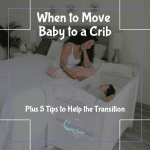
Co-sleeping can be a bit of a controversial topic. Some parents are committed co-sleepers, while others refuse to co-sleep at all (for a variety of reasons).
In our 15+ years of personally helping sleepless families, we have learned that most families don’t fall into either of these two extremes. Instead, we see families who never intended to co-sleep, but do it because it helps everyone get more sleep.
Regardless of why you started co-sleeping, you may find there comes a time when you are ready to stop co-sleeping and move your baby or toddler into a crib or a bed. But this is one of those ‘easier-said-than-done’ things, isn’t it? Way easier for me to type ‘transition away from co-sleeping’ than it is for you to actually do it!
Fortunately, we are here to help with this process. Today, we’re sharing tips about how you can gently transition your baby or toddler away from co-sleeping.
4 Steps to Stop Co-Sleeping:
You can use these 4 steps to gently transition your baby or toddler away from co-sleeping, and towards sleeping in their own bed (and hopefully sleeping through the night!):
Step 1: Lay the groundwork.
For babies, you should make sure they have ample play time (NOT sleep time!) in the room and crib, so it is familiar. For toddlers, start by explaining the transition, and pointing out all the good things about it – big kid bed, new sheets, etc. There are even books on the topic such as books like this one designed for your toddler, to help them feel better about the transition.
Step 2: Sleep together in the “new” room.
Consider moving to your baby or toddler’s room, temporarily, to help them grow more comfortable with the new sleep space. As the days go on, add more and more distance between you as they fall asleep. It’s very often easier to get you out of their room than them out of yours! One or two weeks is all you need for this step.
Step 3: Sit by the crib or bed while your baby or toddler falls asleep.
When you feel ready, remove your sleeping arrangements out of your little one’s room, and instead sit on a chair by the crib or bed, and stay with your baby or toddler while they fall asleep. If this is tough for your little one, offer whatever comfort is necessary, but avoid getting in bed with them. Otherwise, this would be a step backward in the process. Once your little one is asleep, leave. Ideally, it should take less and less time for your child to fall asleep each night, as they grow more comfortable with the new arrangement.
Step 4: Leave the room before your baby or toddler falls asleep.
It’s hard to say exactly when you will be ready for this step as all children are unique. But, once you feel your little one is ready, do your bedtime routine, settle your baby or toddler into bed, and then leave. Once you’ve reached this point, you can consider the transition done, even though some nights may be easier than others.
(A special note for our VIP Members. If you are looking for resources to help you gently stop co-sleeping, be sure to check out our day-by-day co-sleeping transition plan, a special VIP members-only resource! Written by our very own expert sleep consultants, this plan will walk you through every step of the transition process. Check it out today!)
In the end, what we want to leave you with is this… There is no “right” or “wrong” sleeping arrangement for you and your baby, provided your sleeping arrangements are safe. Safe bed-sharing, safe room-sharing, safe crib-sleeping…it can all work! And your baby can sleep well, and peacefully, in any sleeping arrangement. If you know you’re ready to transition away from co-sleeping – we can help!








